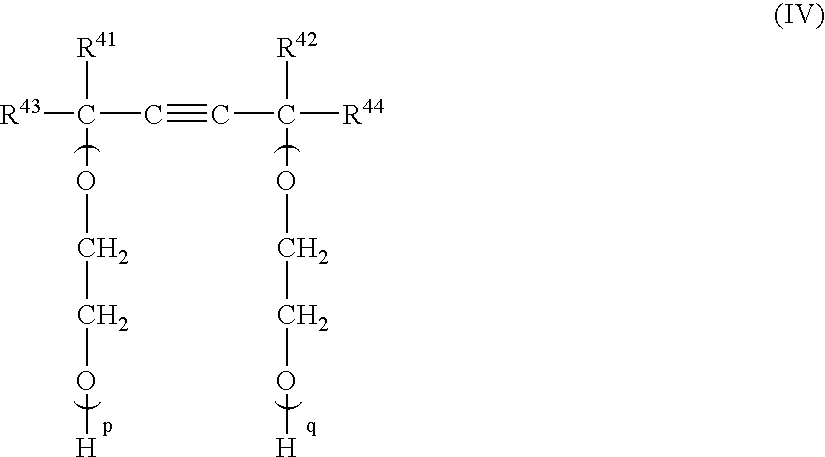Oily ink composition for ink-jet recording, and ink-jet recording method
a technology of oil based ink and ink jet, which is applied in the direction of inks, printing, instruments, etc., can solve the problems of inability to print inability to stabilize ink ejection or corrosion of the head, and poor water resistance of images printed with water based inks
- Summary
- Abstract
- Description
- Claims
- Application Information
AI Technical Summary
Benefits of technology
Problems solved by technology
Method used
Image
Examples
example 1
(1) Formulations of Ink Compositions
[0068]Four ink compositions consisting of the following components were prepared.
(a) Formulation of Yellow Ink Composition
[0069]
C.I. Pigment Yellow 1504.0 wt %Acrylic acid copolymer (dispersant)2.4 wt %Mixed organic solvent A93.1 wt % Vinyl chloride-vinyl acetate copolymer (binder resin)0.5 wt %
(b) Formulation of Magenta Ink Composition
[0070]
C.I. Pigment Red 1224.0 wt %Acrylic acid copolymer (dispersant)2.0 wt %Mixed organic solvent A93.5 wt % Vinyl chloride-vinyl acetate copolymer (binder resin)0.5 wt %
(c) Formulation of Cyan Ink Composition
[0071]
C.I. Pigment Blue 15:44.0 wt %Acrylic acid copolymer (dispersant)1.8 wt %Mixed organic solvent A93.7 wt % Vinyl chloride-vinyl acetate copolymer (binder resin)0.5 wt %
(d) Formulation of Black Ink Composition
[0072]
Carbon black4.0 wt %Acrylic acid copolymer (dispersant)1.8 wt %Mixed organic solvent A93.7 wt % Vinyl chloride-vinyl acetate copolymer (binder resin)0.5 wt %
(2) Preparation of Ink Compositions
[0...
example 2
(1) Formulations of Ink Compositions
[0075]Four ink compositions comprising the following components were prepared.
(a) Formulation of Yellow Ink Composition
[0076]
C.I. Pigment Yellow 1504.0 wt %Polyester compound (dispersant)2.4 wt %Polyoxyethylene derivative0.5 wt %Mixed organic solvent A93.1 wt %
(b) Formulation of Magenta Ink Composition
[0077]
C.I. Pigment Red 1224.0 wt %Polyester compound (dispersant)2.0 wt %Polyoxyethylene derivative0.5 wt %Mixed organic solvent A93.5 wt %
(c) Formulation of Cyan Ink Composition
[0078]
C.I. Pigment Blue 15:44.0 wt %Polyester compound (dispersant)1.8 wt %Polyoxyethylene derivative0.5 wt %Mixed organic solvent A93.7 wt %
(d) Formulation of Black Ink Composition
[0079]
Carbon black4.0 wt %Polyester compound (dispersant)1.8 wt %polyoxyethylene derivative0.5 wt %Mixed organic solvent A93.7 wt %
(2) Preparation of Ink Compositions
[0080]The pigment, dispersant and part of mixed organic solvent A out of the above-described components were stirred in a dissolv...
example 3
(1) Formulations of Ink Compositions
[0082]Six ink compositions comprising the following components were prepared.
(a) Formulation of Yellow Ink Composition
[0083]
C.I. Pigment Yellow 1504.0 wt %Polyester compound (dispersant)2.5 wt %Polyoxyethylene derivative2.0 wt %Cellulose acetate butyrate (binder resin)0.2 wt %Mixed organic solvent B91.3 wt %
(b) Formulation of Magenta Ink Composition
[0084]
C.I. Pigment Red 1224.0 wt %Polyester compound (dispersant)2.0 wt %Polyoxyethylene derivative2.0 wt %Cellulose acetate butyrate (binder resin)0.2 wt %Mixed organic solvent B91.8 wt %
(c) Formulation of Light Magenta Ink Composition
[0085]
C.I. Pigment Red 1221.0 wt %Polyester compound (dispersant)0.5 wt %Polyoxyethylene derivative0.5 wt %Cellulose acetate butyrate (binder resin)0.8 wt %Mixed organic solvent B97.2 wt %
(d) Formulation of Black Ink Composition
[0086]
Carbon black4.0 wt %Polyester compound (dispersant)2.0 wt %Polyoxyethylene derivative2.0 wt %Cellulose acetate butyrate (binder resin)0.2...
PUM
| Property | Measurement | Unit |
|---|---|---|
| Percent by mass | aaaaa | aaaaa |
| Percent by mass | aaaaa | aaaaa |
| Percent by mass | aaaaa | aaaaa |
Abstract
Description
Claims
Application Information
 Login to View More
Login to View More - R&D
- Intellectual Property
- Life Sciences
- Materials
- Tech Scout
- Unparalleled Data Quality
- Higher Quality Content
- 60% Fewer Hallucinations
Browse by: Latest US Patents, China's latest patents, Technical Efficacy Thesaurus, Application Domain, Technology Topic, Popular Technical Reports.
© 2025 PatSnap. All rights reserved.Legal|Privacy policy|Modern Slavery Act Transparency Statement|Sitemap|About US| Contact US: help@patsnap.com



